The Frequency of Extreme Cold Events in North China and Their Relationship with Sea Surface Temperature Anomalies
Abstract
:1. Introduction
2. Data and Methods
2.1. Data
2.2. Methods
2.2.1. Definition of the SSECE
2.2.2. Harmonic Analysis
2.2.3. Pearson Correlation Coefficient and Partial Correlation Coefficient
2.2.4. Rossby Wave Activity Flux
3. Results
3.1. The Spatiotemporal Characteristics of the Interdecadal SSECE Frequency
3.1.1. The Basic Interdecadal Characteristics
3.1.2. The Interdecadal Spatial and Temporal Modes of the SSECE Frequency
3.2. Possible Causes of the “n” Pattern in the SSECE Frequency
3.2.1. Interdecadal Coupled Modes of SST, SSECE Frequency, and H500
3.2.2. Interdecadal Characteristics of the Atmospheric Circulation in the Upper and Lower Troposphere
3.3. Possible Causes of the East–West Inverse Anomalous Mode in the SSECE Frequency
3.3.1. Definition of SST Index
3.3.2. Correlation between the SST Index and PC1
3.3.3. Correlation between SST Index and Atmospheric Circulation Elements
4. Conclusions and Discussion
4.1. Conclusions
- (a)
- The SSECE frequency in North China showed an interdecadal transition around 1991, with frequent occurrence before 1991, less from 1992 to 2017, and increasing again since 2018. The frequency of SSECEs decreases from northwest to southeast. The interdecadal distributions of the SSECE frequency mainly include east–west inverse dipole mode, “n” mode, north-south inverse dipole mode, and “saddle-like” mode. The interdecadal transition point of the first mode, namely the east–west inverse dipole mode, is consistent with that of the regional average SSECE frequency in North China, and the transition point of the second mode is around 1997/1998.
- (b)
- The synergistic effects of the IPO and AMO SST interdecadal anomalies may be the main reason for the “n” mode interdecadal anomalies of the SSECE frequency. Before 1997/1998, the synergisms of +IPO and −AMO stimulated the teleconnection wave train from the Pacific to Eurasia. The −EUP pattern circulation anomaly of “two troughs and one ridge” in Eurasia propagated Rossby wave energy from upstream to downstream, deepening the Urals trough and the East Asian trough, strengthening the Lake Baikal blocking High, weakening the SH in the north and strengthening in the south, combined with the strong temperate jet and weak subtropical jet in the upper troposphere. As a result, the polar cold air invades North China via the Barents Sea, West Siberia, Central Siberia, and along the northward flow in front of the Lake Baikal ridge, resulting in frequent SSECEs in central North China in winter. The opposite is true after 1997/1998.
- (c)
- The synergistic effects of SSTAs among the Indian Ocean, Pacific, and North Atlantic may be an important reason for the east–west reverse dipole interdecadal anomaly of the SSECE frequency in North China in winter. Before 1991, the SST in the central North Atlantic was higher, and lower in the equatorial Indian Ocean and the tropical southwest Pacific, which caused a “+”, “−”, “+”, and “−” anomalous wave trains at mid-latitudes from the Atlantic to the North Pacific in the middle and lower troposphere. The Rossby wave energy propagated eastward from the North Atlantic, resulting in the stronger SH, and deeper Aleutian Low with a southerly location, stronger Urals blocking high, and deeper East Asian trough being located westward. The northerly airflow in front of the Urals ridge and behind the East Asian trough guided the polar cold air to travel southward along Novaya Zemlya, Western Siberian Plain, Inner Mongolia, and to reach North China, leading to the frequent occurrence of SSECEs in winter in central-eastern China before 1991, the opposite is true between 1992 and 2018.
4.2. Discussion
Author Contributions
Funding
Institutional Review Board Statement
Informed Consent Statement
Data Availability Statement
Acknowledgments
Conflicts of Interest
References
- Seneviratne, S.I.; Nicholls, N.; Easterling, D.; Goodess, C.M.; Kanae, S.; Kossin, J.; Luo, Y.; Marengo, J.; McInnes, K.; Rahimi, M.; et al. 2012: Changes in climate extremes and their impacts on the natural physical environment. In Managing the Risks of Extreme Events and Disasters to Advance Climate Change Adaptation; Field, C.B., Barros, V., Stocker, T.F., Qin, D., Dokken, D.J., Ebi, K.L., Mastrandrea, M.D., Mach, K.J., Plattner, G.-K., Allen, S.K., et al., Eds.; A Special Report of Working Groups I and II of the Intergovernmental Panel on Climate Change (IPCC); Cambridge University Press: Cambridge, UK; New York, NY, USA, 2012; pp. 109–230. [Google Scholar] [CrossRef]
- Donat, M.G.; Alexander, L.V.; Yang, H.; Durre, I.; Vose, R.; Dunn, R.J.H.; Willett, K.M.; Aguilar, E.; Brunet, M.; Caesar, J.; et al. Updated Analyses of Temperature and Precipitation Extreme Indices since the Beginning of the Twentieth Century: The HadEX2 Dataset. J. Geophys. Res. Atmos. 2013, 118, 2098–2118. [Google Scholar] [CrossRef]
- Zhou, B.T.; Qian, J. Changes of weather and climate extremes in the IPCC AR6. Clim. Chang. Res. 2021, 17, 713–718. Available online: http://www.climatechange.cn/CN/10.12006/j.issn.1673-1719.2021.167 (accessed on 15 May 2023).
- Wei, J.H.; Lin, Z.H. The Leading Mode of Wintertime Cold Wave Frequency in Northern China during the Last 42 Years and Its Association with Arctic Oscillation. Atmos. Ocean. Sci. Lett. 2009, 2, 130–134. [Google Scholar] [CrossRef]
- Yao, Y.M.; Yao, L.; Deng, W.T. Analysis of the frequency characteristics of the similar cold wave in the middle and lower reaches of the Yangtze River. Meteorol. Mon. 2011, 37, 339–344. Available online: https://d.wanfangdata.com.cn/periodical/qx201103012 (accessed on 15 May 2023).
- Wu, H.Y.; Du, Y.D. Climatic characteristics of cold caves in South China in the period 1961-2008. Clim. Chang. Res. 2010, 6, 192–197. [Google Scholar] [CrossRef]
- Kang, Z.M.; Jin, R.H.; Bao, Y.Y. Characteristic analysis of cold wave in China during the period of 1951–2006. Plateau Meteorol. 2010, 29, 420–428. Available online: http://www.gyqx.ac.cn/CN/Y2010/V29/I2/420 (accessed on 15 May 2023).
- Ding, Y.H.; Wang, Z.Y.; Song, Y.F.; Zhang, J. Causes of the unprecedented freezing disaster in January 2008 and its possible association with global warming. Acta Meteorol. Sin. 2008, 66, 808–825. [Google Scholar] [CrossRef]
- Gao, H.; Chen, L.J.; Jia, X.L.; Ke, Z.J.; Han, Z.Q.; Zhang, P.Q.; Wang, Q.Y.; Sun, C.H.; Zhu, Y.F.; Li, W.; et al. Analysis of the severe cold surge, ice-snow and frozen disasters in South China during January 2008 II. possible climatic causes. Meteorol. Mon. 2008, 34, 101–106. Available online: https://d.wanfangdata.com.cn/periodical/qx200804013 (accessed on 15 May 2023).
- Miao, C.S.; Zhao, Y.; Wang, J.H. Numerical simulation of 080125 cold air, freezing rain, and snow in Southern China. Trans. Atmos. Sci. 2010, 33, 25–33. [Google Scholar] [CrossRef]
- Lu, C.H.; Wang, R.; Qin, Y.J.; Ma, L.B. Effect of stratospheric downward propagation on the large-scale snowfall of Northern Hemisphere in December 2009. Trans. Atmos. Sci. 2012, 35, 304–310. [Google Scholar] [CrossRef]
- Shi, C.H.; Cai, W.Y.; Jin, X. Modulation by transient waves of atmospheric longwave anomalies: Dynamic mechanism of the super cold wave in South China in the extremely strong El Niño of 2015/2016. Trans. Atmos. Sci. 2016, 39, 827–834. [Google Scholar] [CrossRef]
- Li, F.; Jiao, M.Y.; Ding, Y.H.; Jin, R.H. Climate Change of Arctic Atmospheric Circulation in Last 30 Years and Its Effect on Strong Cold Events in China. Plateau Meteorol. 2006, 25, 209–219. [Google Scholar] [CrossRef]
- Wang, Z.Y.; Ding, Y.H. Climate change of the cold wave frequency of China in the last 53 years and the possible reasons. Chin. J. Atmos. Sci. 2006, 30, 1068–1076. [Google Scholar] [CrossRef]
- Fu, D.X.; Sun, Z.B.; Li, Z.X.; Ni, D.H. Spatial and temporal features of China’s extreme minimum temperature in winter half year during 1955–2006. J. Meteorol. Sci. 2011, 31, 274–281. [Google Scholar] [CrossRef]
- Ma, T.T.; Wu, Z.W.; Jiang, Z.H. How does cold wave frequency in China respond to a warming climate. Clim. Dyn. 2012, 39, 2487–2496. [Google Scholar] [CrossRef]
- Wang, H.J. Preliminary results of the 973 project on the energy and water cycle and their role in extreme climate of China. Adv. Earth Sci. 2010, 25, 563–570. Available online: http://www.adearth.ac.cn/CN/10.11867/j.issn.1001-8166.2010.06.0563 (accessed on 15 May 2023).
- Ren, G.Y.; Feng, G.L.; Yan, Z.W. Progresses in observation studies of climate extremes and changes in mainland China. Clim. Environ. Res. 2010, 15, 337–353. [Google Scholar] [CrossRef]
- Wang, D.; You, Q.L.; Jiang, Z.H.; Wu, W.B.; Jiao, Y. Analysis of Extreme Temperature Changes in China based on the Homogeneity-Adjusted Data. Plateau Meteorol. 2016, 35, 1352–1363. Available online: http://www.gyqx.ac.cn/CN/10.7522/j.issn.1000–0534.2016.00019 (accessed on 15 May 2023).
- Xie, S.Q.; Lu, C.H. Intensification of winter cold events over the past 16 years in the mid-latitudes of Eurasia and their causes. Trans. Atmos. Sci. 2018, 41, 423–432. [Google Scholar] [CrossRef]
- Yang, J.H.; Shen, Y.P.; Wang, P.X.; Yang, Q.G. Extreme low temperature events in northwest China and their response to regional warming in the recent 45 Years. J. Glaciol. Geocryol. 2007, 29, 536–542. [Google Scholar] [CrossRef]
- Chen, S.Y.; Wang, J.S.; Ren, Y.; Qiao, L. Evaluative Characteristic of Extreme Minimum Temperature of Northwest China in Recent 49 Years. Plateau Meteorol. 2011, 30, 1266–1273. Available online: http://www.gyqx.ac.cn/CN/Y2011/V30/I5/1266 (accessed on 15 May 2023).
- Zhang, F.Y.; Xu, H.M. Spatial/temporal variations of spring extreme low temperature in Northeast China and its relationship with SSTA in Atlantic Ocean. Trans. Atmos. Sci. 2011, 34, 574–582. [Google Scholar] [CrossRef]
- Qin, Y.L. Variation of Extreme Temperature in Northeast China and Its Relations with Atmospheric Circulation During Summertime. Master’s Thesis, Nanjing University of Information Science & Technology, Nanjing, China, 2012. [Google Scholar]
- Liu, Y.; Guo, P.W.; Feng, T. The relationship between winter persistent abnormal low temperature in North China and atmospheric low frequency oscillation activities. Trans. Atmos. Sci. 2016, 39, 370–380. [Google Scholar] [CrossRef]
- Li, L.P.; Ni, W.J.; Li, Y.G.; Guo, D.; Gao, H. Impacts of Sea Surface Temperature and Atmospheric Teleconnection Patterns in the Northern Mid-Latitudes on Winter Extremely Cold Events in North China. Adv. Meteorol. 2021, 2021, 8853457. [Google Scholar] [CrossRef]
- Li, C.Y.; He, J.H.; Zhu, J.H. A review of decadal/interdecadal climate variation studies in China. Adv. Atmos. Sci. 2004, 21, 425–436. [Google Scholar] [CrossRef]
- Zhang, Q.Y.; Tao, S.Y.; Peng, J.B. The studies of meteorological disasters over China. Chin. J. Atmos. Sci. 2008, 32, 815–825. [Google Scholar] [CrossRef]
- Wei, K.; Chen, W.; Zhou, W. Changes in the East Asian cold season since 2000. Adv. Atmos. Sci. 2011, 28, 69–79. [Google Scholar] [CrossRef]
- Wallace, J.M.; Gutzler, D.S. Teleconnections in the Geopotential Height Field during the Northern Hemisphere Winter. Mon. Weather Rev. 1981, 109, 784–812. [Google Scholar] [CrossRef]
- Liess, S.; Agrawal, S.; Chatterjee, S.; Kumar, V. A teleconnection between the West Siberian Plain and the ENSO region. J. Clim. 2017, 30, 301–315. [Google Scholar] [CrossRef]
- Bueh, C.; Fu, X.Y.; Xie, Z.W. Large-Scale Circulation Features Typical of Wintertime Extensive and Persistent Low Temperature Events in China. Atmos. Ocean. Sci. Lett. 2011, 4, 235–241. [Google Scholar] [CrossRef]
- Tan, B.K.; Chen, W. Progress in the study of the dynamics of extratropical atmospheric teleconnection patterns and their impacts on East Asian climate. Acta Meteorol. Rev. 2014, 75, 908–925. [Google Scholar] [CrossRef]
- Liu, Y.Z.; Wang, L. Interdecadal changes of scandinavian teleconnection pattern in the late 1970s. Clim. Environ. Res. 2014, 19, 371–382. [Google Scholar] [CrossRef]
- Zhou, P.; Suo, L.; Yuan, J.; Tan, B. The East Pacific Wavetrain: Its Variability and Impact on the Atmospheric Circulation in the Boreal Winter. Adv. Atmos. Sci. 2012, 29, 471–483. [Google Scholar] [CrossRef]
- Wang, L.; Liu, Y.Y.; Zhang, Y.; Chen, W.; Chen, S.F. Time-varying structure of the wintertime Eurasian pattern: Role of the North Atlantic sea surface temperature and atmospheric mean flow. Clim. Dyn. 2019, 52, 2467–2479. [Google Scholar] [CrossRef]
- Ding, Y.H. Physical problems in the global climate change. Physics 2009, 38, 71–83. [Google Scholar] [CrossRef]
- Li, C.Y. On possible mechanisms of interdecadal climate variability. Clim. Environ. Res. 2019, 24, 1–21. [Google Scholar] [CrossRef]
- Zhu, Y.F.; Tan, G.R.; Wang, Y.G. Variation of spatial mode for winter temperature in China and its relationship with the large scale atmospheric circulation. Clim. Chang. Res. 2007, 3, 266–270. [Google Scholar] [CrossRef]
- Ding, Y.H. Build-up, air mass transformation and propagation of Siberian high and its relations to cold surge in East Asia. Meteorl. Atmos. Phys. 1990, 44, 281–292. [Google Scholar] [CrossRef]
- Zhang, Y.; Sperber, K.R.; Boyle, J.S. Climatology and interannual variation of the east Asian winter monsoon: Results from the 1979-95 NCEP/NCAR reanalysis. Mon. Weather Rev. 1997, 125, 2605–2619. [Google Scholar] [CrossRef]
- Gong, D.Y.; Ho, C.H. The Siberian High and climate change over middle to high latitude Asia. Theor. Appl. Climatol. 2002, 72, 1–9. [Google Scholar] [CrossRef]
- Thompson, D.W.; Wallace, J.M. The Arctic oscillation signature in the wintertime geopotential height and temperature fields. Geophys. Res. Lett. 1998, 25, 1297–1300. [Google Scholar] [CrossRef]
- Van, L.H.; Rogers, J.C. The Seesaw in Winter Temperatures between Greenland and Northern Europe. Part I: General Description. Mon. Weather Rev. 1978, 106, 296–310. [Google Scholar] [CrossRef]
- Wu, B.Y.; Huang, R.H. Effects of the Extremes in the North Atlantic Oscillation on East Asia Winter Monsoon. Chin. J. Atmos. Sci. 1999, 23, 641–651. [Google Scholar] [CrossRef]
- Han, F.H.; Chen, H.S.; Ma, H.D. Interdecadal Variations in the Relationship between the Winter North Atlantic Oscillation and Extreme Low Temperature over Northern China. Chin. J. Atmos. Sci. 2018, 42, 239–250. [Google Scholar] [CrossRef]
- Zuo, J.Q.; Ren, H.L.; Li, W.J.; Wang, L. Interdecadal Variations in the Relationship between the Winter North Atlantic Oscillation and Temperature in South-Central China. J. Clim. 2016, 29, 7477–7493. [Google Scholar] [CrossRef]
- Li, C.Y.; Liao, Q.H. Quasi-decadal oscillation of climate in East Asia/northwestern Pacific region and possible mechanism. Clim. Environ. Res. 1996, 1, 124–133. [Google Scholar] [CrossRef]
- Gu, W.; Li, C.Y.; Wang, X.; Zhou, W.; Li, W.J. Linkage between Mei-yu precipitation and North Atlantic SST on the decadal timescale. Adv. Atmos. Sci. 2009, 26, 101–108. [Google Scholar] [CrossRef]
- Minobe, S.; Mantua, N. Interdecadal modulation of interannual atmospheric and oceanic variability over the North Pacific. Prog. Oceanogr. 1999, 43, 163–192. [Google Scholar] [CrossRef]
- Liu, Q.Y.; Li, C.; Hu, R.J. Interdecadal oscillations in the North Pacific and global warming. Clim. Environ. Res. 2010, 15, 217–224. [Google Scholar] [CrossRef]
- Mantua, N.J.; Hare, S.R.; Zhang, Y.; Wallace, J.M.; Francis, R.C. A Pacific interdecadal climate oscillation with impacts on salmon production. Bull. Amer. Meteor. Soc. 1997, 78, 1069–1079. [Google Scholar] [CrossRef]
- Li, C.Y.; Xian, P. Interdecadal variation of SST in the North Pacific and the anomalies of atmospheric circulation and climate. Clim. Environ. Res. 2003, 8, 258–273. [Google Scholar] [CrossRef]
- Yang, X.Q.; Zhu, Y.M.; Xie, Q.; Ren, X.J.; Xu, G.Y. Advances in studies of Pacific Decadal Oscillation. Chin. J. Atmos. Sci. 2004, 28, 979–992. [Google Scholar] [CrossRef]
- Li, L.P.; Wang, P.X.; Zheng, X.Y. Diagnostic analysis on temporal-spatial characteristics of sub-surface sea temperature and air-sea interaction over the North Pacific. J. Nanjing Inst. Meteorol. 2003, 26, 145–154. [Google Scholar] [CrossRef]
- Gallego, B.; Cessi, P. Decadal variability of two oceans and an atmosphere. J. Clim. 2001, 14, 2815–2832. [Google Scholar] [CrossRef]
- Zhu, Y.M.; Yang, X.Q.; Xie, Q.; Yu, Y.Q. The Covariant modes between sea surface temperature in the Pacific Ocean and mid-latitude in the northern hemisphere atmospheric circulation anomalies in winter. Prog. Nat. Sci. 2008, 18, 161–171. [Google Scholar] [CrossRef]
- McCabe, G.J.; Palecki, M.A.; Betancourt, J.L. Pacific and Atlantic Ocean influences on multidecadal drought frequency in the United States. Proc. Natl. Acad. Sci. USA 2004, 101, 4136–4141. [Google Scholar] [CrossRef]
- Chen, J.Y.; Delgenio, A.D.; Carlson, B.E.; Bosilovich, M.G. The spatiotemporal structure of twentieth-century climate variations in observations and reanalyses. Part II: Pacific pan-decadal Variability. J. Clim. 2008, 21, 2634–2650. [Google Scholar] [CrossRef]
- Dong, B.; Dai, A.G. The influence of the Interdecadal Pacific Oscillation on Temperature and Precipitation over the Globe. Clim. Dyn. 2015, 45, 2667–2681. [Google Scholar] [CrossRef]
- Li, S.L. Impact of Northwest Atlantic SST anomalies on the circulation over the Ural Mountains during early winter. J. Meteorol. Soc. Jpn. 2004, 82, 971–988. [Google Scholar] [CrossRef]
- Qu, J.H.; Jiang, Z.H.; Tan, G.R.; Sun, L. Relation between interannual, interdecadal variability of SST in North Atlantic in winter and air temperature in China. Sci. Geogr. Sin. 2006, 26, 557–563. [Google Scholar] [CrossRef]
- Li, S.L.; Bates, G.T. Influence of the Atlantic multidecadal oscillation on the winter climate of East China. Adv. Atmos. Sci. 2007, 24, 126–135. [Google Scholar] [CrossRef]
- Ding, T.; Qian, W.H.; Yan, Z.W. Characteristics and changes of cold surge events over China during 1960–2007. Atmos. Ocean. Sci. Lett. 2009, 2, 339–344. [Google Scholar] [CrossRef]
- Liu, J.; Xu, X.F.; Luo, H. Econometric Analysis of the Impact of Climate Extremes on Agricultural Economic Output in China. Sci. China Earth Sci. 2012, 42, 1076–1082. [Google Scholar] [CrossRef]
- Kalnay, E.; Kanamitsu, M.; Kistler, R.; Collins, W.; Deaven, D.; Gandin, L.; Joseph, D.; Iredell, M.; Saha, S.; White, G.; et al. The NCEP/NCAR 40-year reanalysis project. Bull. Amer. Meteor. Soc. 1996, 77, 437–472. Available online: https://www.jstor.org/stable/26232740 (accessed on 15 May 2023). [CrossRef]
- Ishii, M.; Shouji, A.; Sugimoto, S.; Matsumoto, T. Objective Analyses of Sea-Surface Temperature and Marine Meteorological Variables for the 20th Century Using ICOADS and the Kobe Collection. Int. J. Climatol. 2005, 25, 865–879. [Google Scholar] [CrossRef]
- GB/T 20484–2017; Grade of Cold Air. Standards Press of China: Beijing, China, 2017.
- GB/T 21987–2017; Grades of Cold Wave. Standards Press of China: Beijing, China, 2017.
- Li, L.P.; Wang, P.X.; Li, H. Interdecadal and interannual variabilities of air and sea and their relations over the Pacific. Acta Meteorol. Sin. 2004, 18, 227–244. Available online: http://jmr.cmsjournal.net/en/article/id/956 (accessed on 15 May 2023).
- Ji, C.X.; Zhang, Y.Z.; Cheng, Q.M.; Li, Y.; Jiang, T.C.; Liang, X.S. On the relationship between the early spring Indian Ocean’s sea surface temperature (SST) and the Tibetan Plateau atmospheric heat source in summer. Glob. Planet. Chang. 2018, 164, 1–10. [Google Scholar] [CrossRef]
- Ashok, K.; Guan, Z.Y.; Yamagata, T. Influence of the Indian Ocean Dipole on the Australian winter rainfall. Geophys. Res. Lett. 2003, 30, 1821. [Google Scholar] [CrossRef]
- Wu, F.M.; Li, W.K.; Zhang, P.; Li, W. Relative Contributions of Internal Atmospheric Variability and Surface Processes to the Interannual Variations in Wintertime Arctic Surface Air Temperatures. J. Clim. 2021, 34, 7131–7148. [Google Scholar] [CrossRef]
- Takaya, K.; Nakamura, H. A Formulation of a Phase-Independent Wave-Activity Flux for Stationary and Migratory Quasigeostrophic Eddies on a Zonally Varying Basic Flow. J. Atmos. Sci. 2001, 58, 608–627. [Google Scholar] [CrossRef]
- Wu, H.B.; Wu, L. Diagnosis and Prediction Method of Climate Variability; China Meteorological Press: Beijing, China, 2005; pp. 208–225. [Google Scholar]
- Wei, F.Y. Modern Climate Statistical Diagnosis and Prediction Techniques, 2nd ed.; China Meteorological Press: Beijing, China, 2007; pp. 10–28. [Google Scholar]
- Wang, P.X.; Duan, M.K.; Li, L.P.; Lu, C.H.; Guo, D.; Sun, X.J. Basic Analysis Method of Atmospheric Circulation and its Application; Science Press: Beijing, China, 2019; pp. 153–165. [Google Scholar]
- North, G.R.; Bell, T.L.; Cahalan, R.F. Sampling Errors in the Estimation of Empirical Orthogonal Functions. Mon. Weather Rev. 1982, 110, 699–706. [Google Scholar] [CrossRef]
- Tian, X.X.; Shou, S.W. Analysis of isentropic vorticity for two cold wave processes in Dec. 2008. J. Meteorol. Sci. 2013, 33, 102–108. [Google Scholar] [CrossRef]
- Tang, W.Y.; Sun, Z.B. Effect of Indian Ocean SSTA on China Temperature Anomaly. J. Nanjing Inst. Meteorol. 2007, 30, 667–673. [Google Scholar] [CrossRef]
- Zheng, F.; Yuan, Y.; Ding, Y.H.; Li, K.X.; Fang, X.H.; Zhao, Y.H.; Sun, Y.; Zhu, J.; Ke, Z.J.; Wang, J.; et al. The 2020/21 Extremely Cold Winter in China Influenced by the Synergistic Effect of La Niña and Warm Arctic. Adv. Atmos. Sci. 2022, 39, 546–552. [Google Scholar] [CrossRef]
- Graf, H.F.; Zanchettin, D. Central Pacific El Niño, the “subtropical bridge”, and Eurasian climate. J. Geophys. Res. 2012, 117, D01102. [Google Scholar] [CrossRef]
- Park, J.; Dusek, G. ENSO components of the Atlantic multidecadal oscillation and their relation to North Atlantic interannual coastal sea level anomalies. Ocean Sci. 2013, 9, 535–543. [Google Scholar] [CrossRef]
- Dong, B.; Dai, A.G.; Vuille, M.; Timm, O.E. Asymmetric Modulation of ENSO Teleconnections by the Interdecadal Pacific Oscillation. J. Clim. 2018, 31, 7337–7361. [Google Scholar] [CrossRef]
- Hu, Q.; Feng, S. AMO-and ENSO-Driven Summertime Circulation and Precipitation Variations in North America. J. Clim. 2012, 25, 6477–6495. [Google Scholar] [CrossRef]



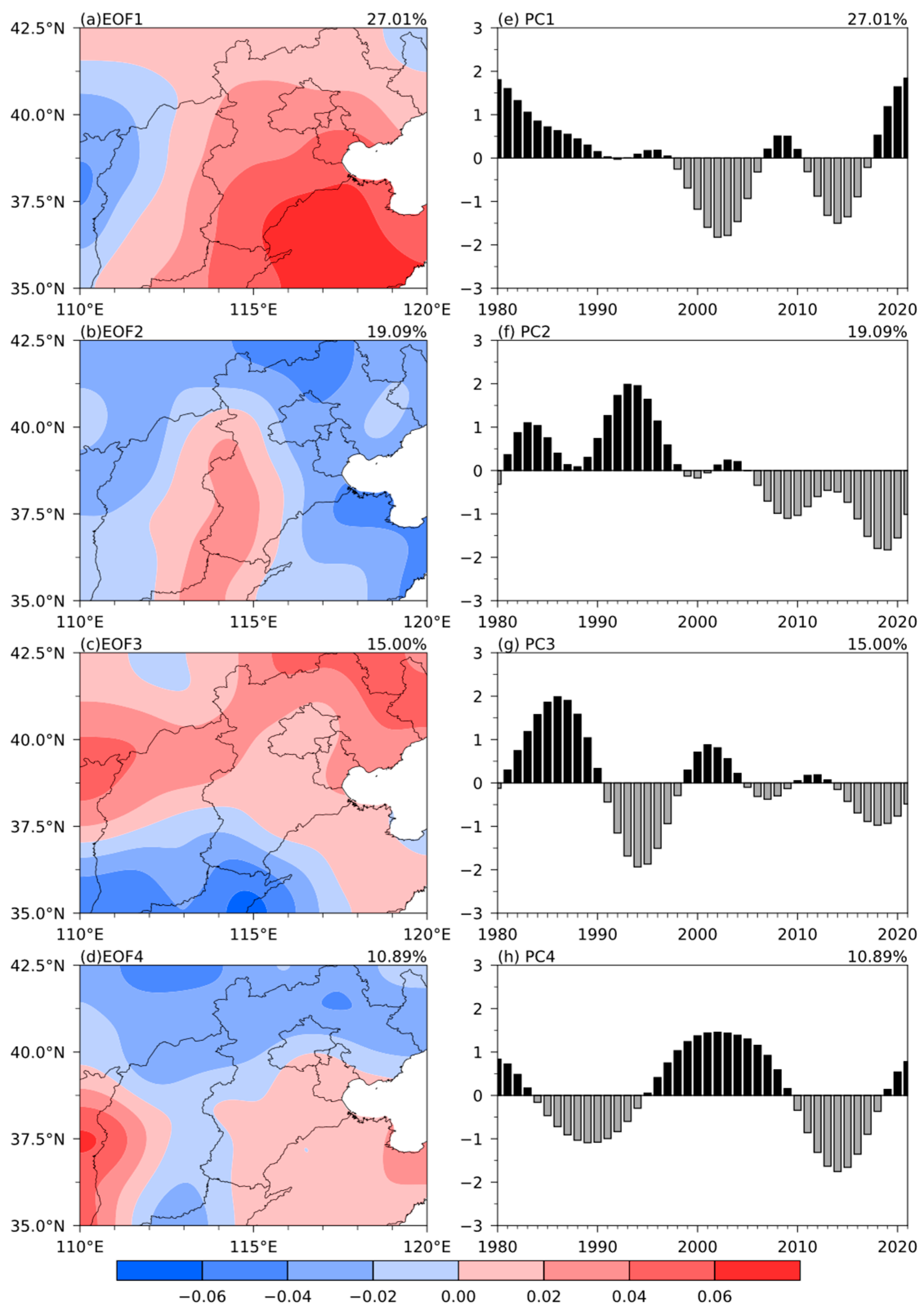
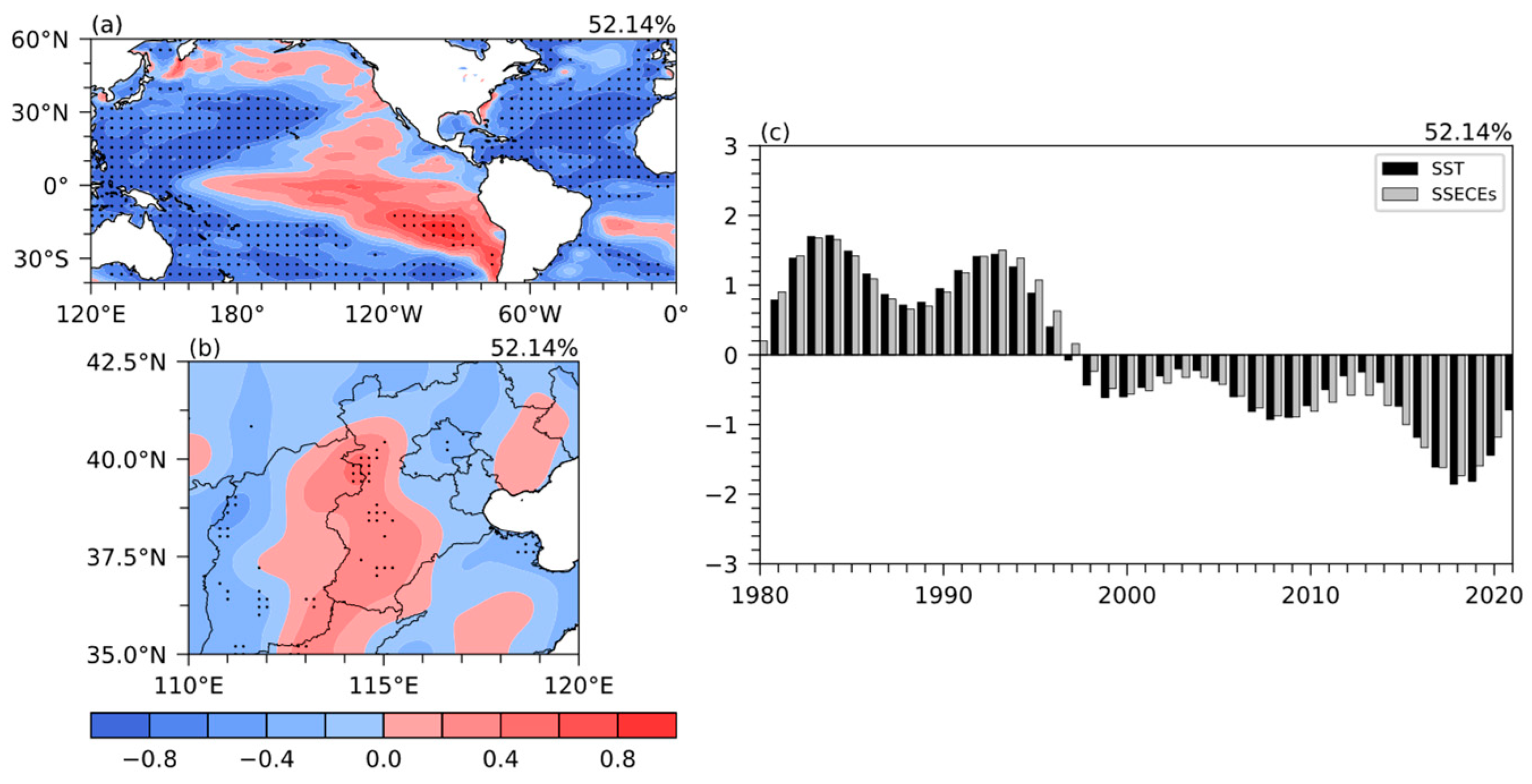
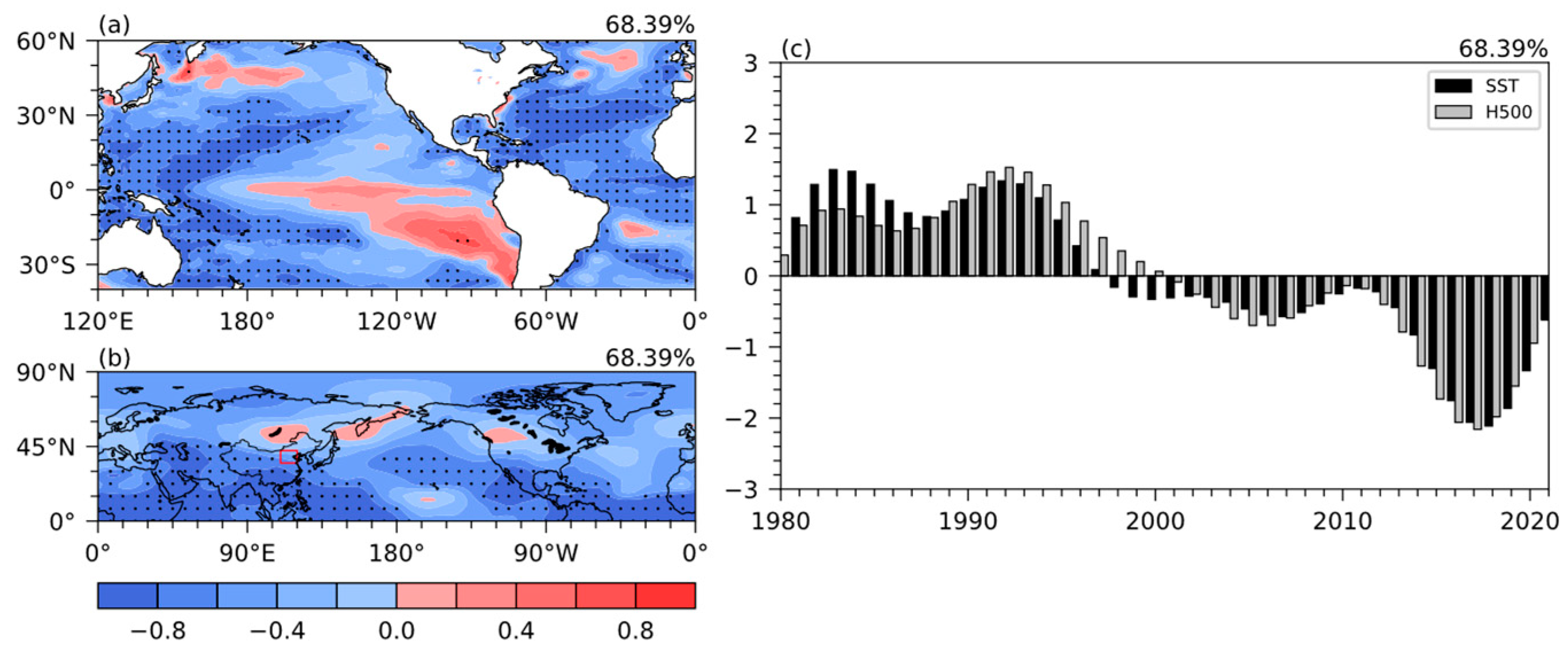
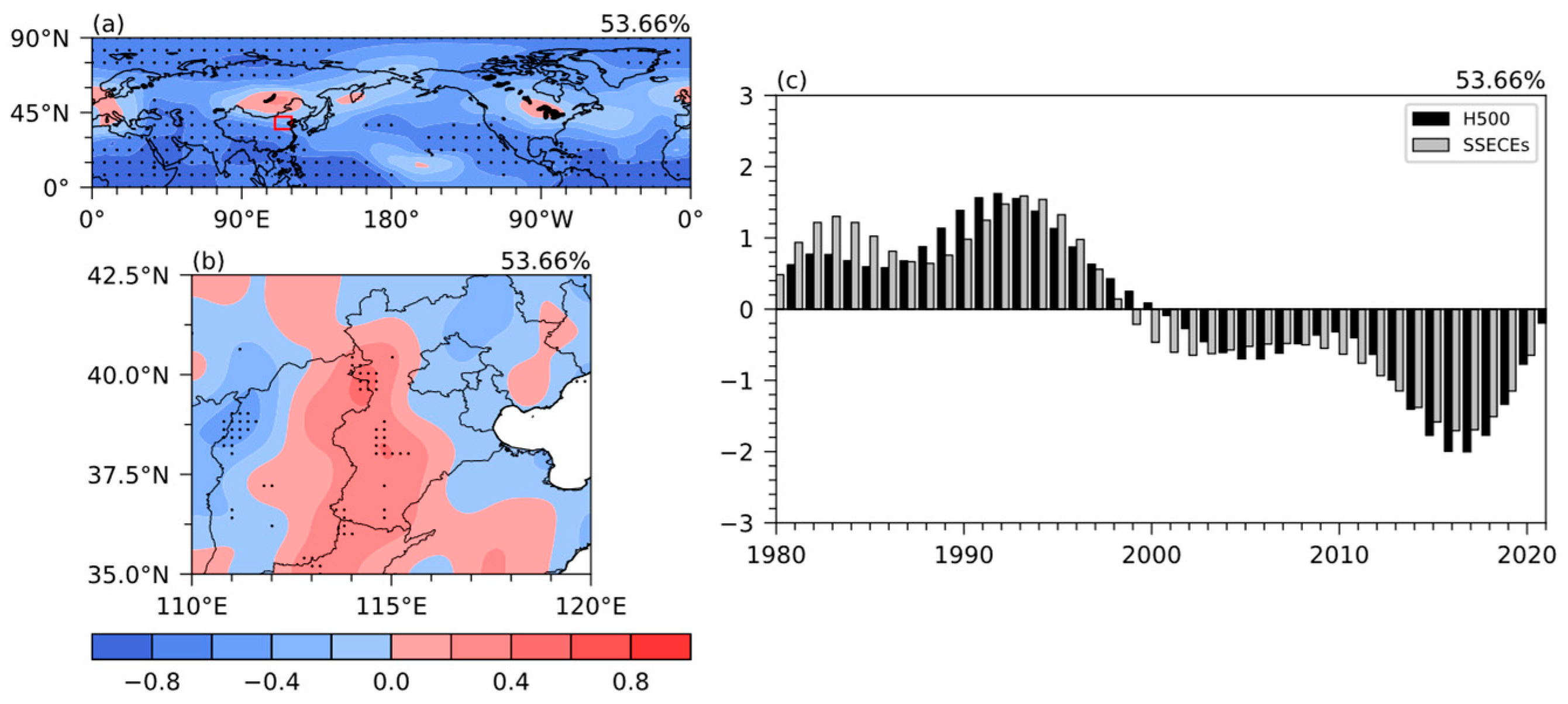
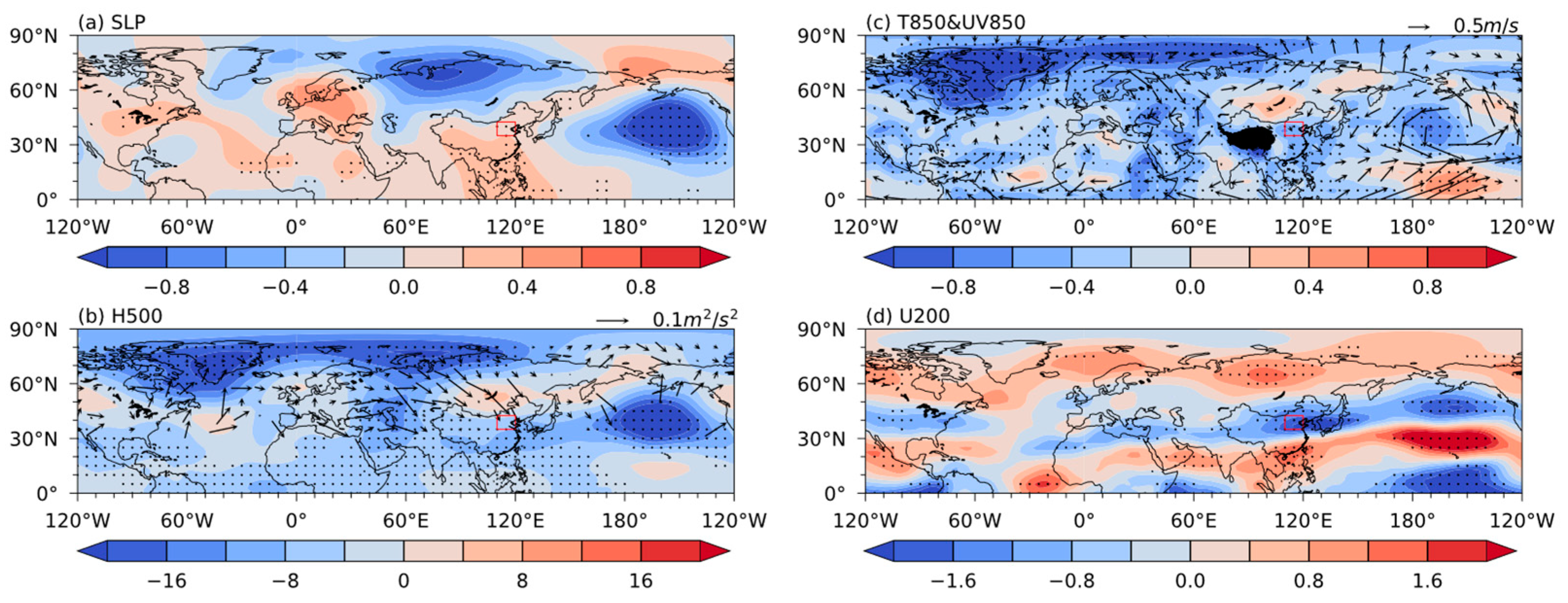
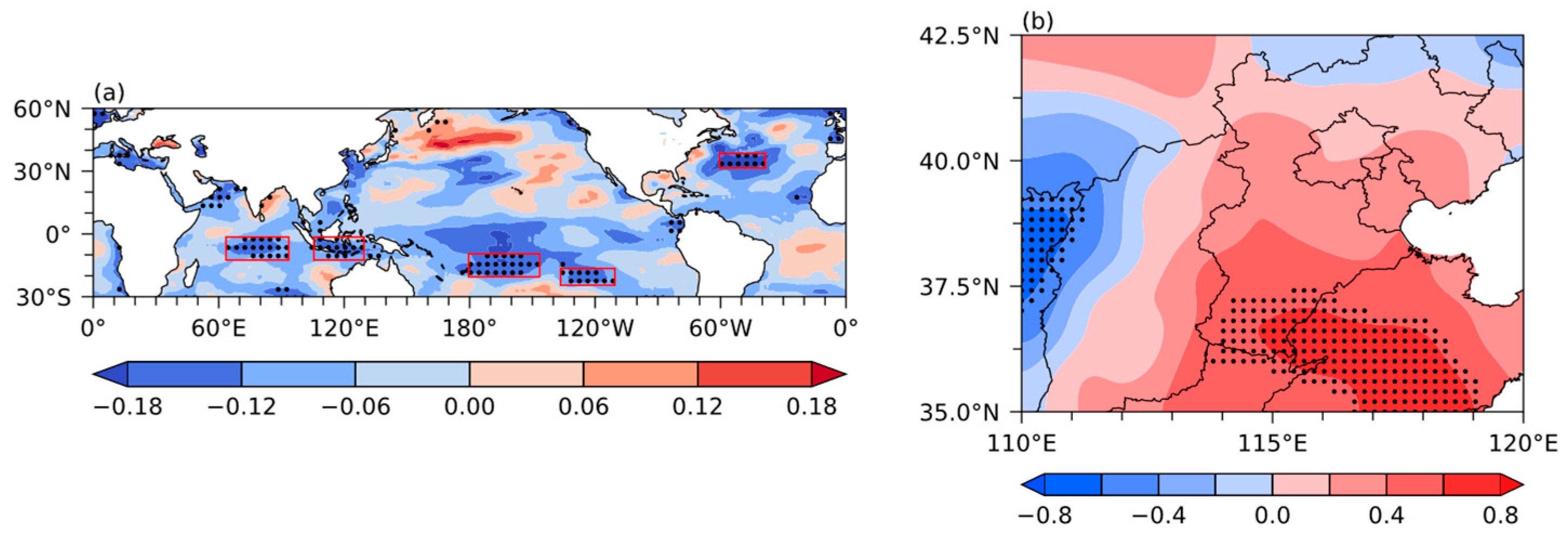
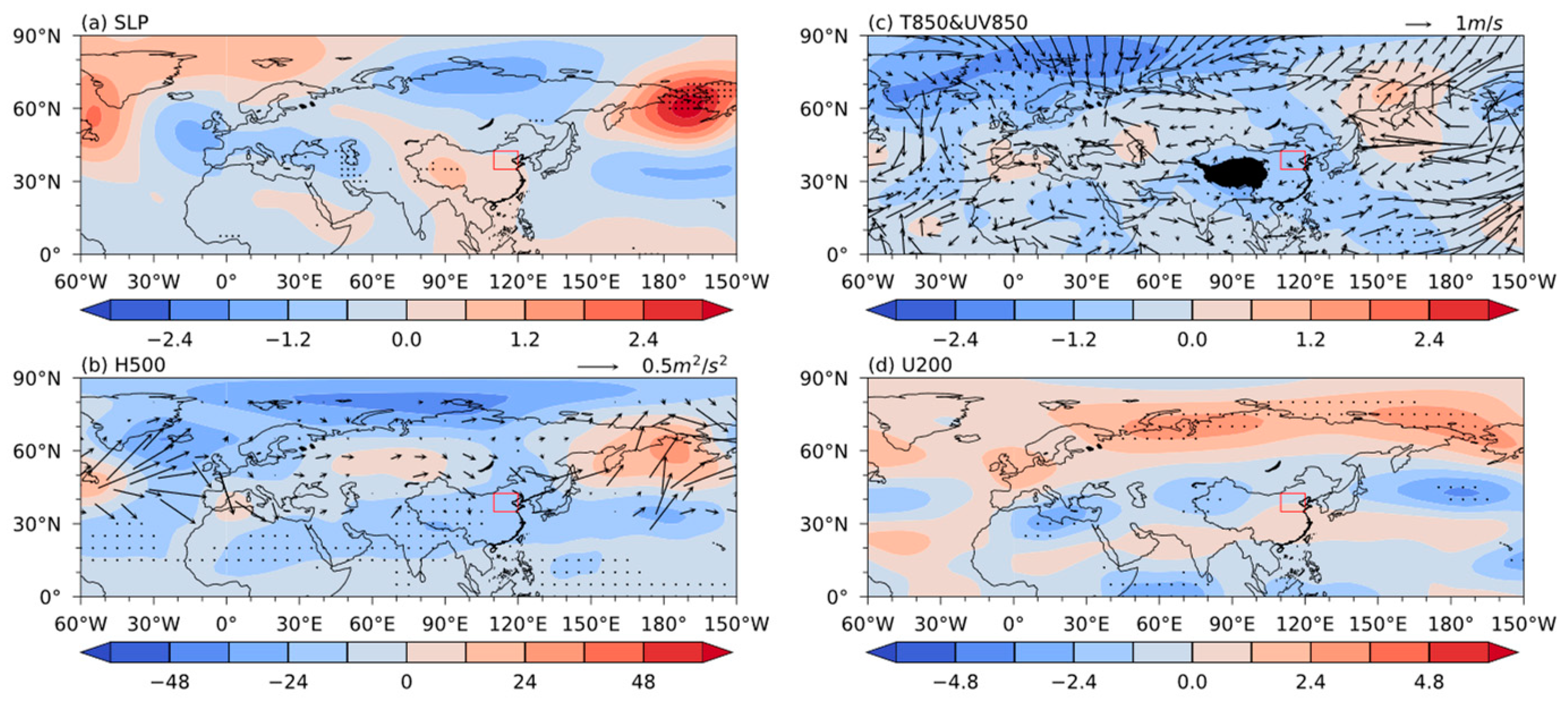
| Pearson Correlation Coefficients | Partial Correlation Coefficients | |
|---|---|---|
| IInd | −0.70 ** | −0.69 ** |
| IPa | −0.75 ** | −0.75 ** |
| IAtl | −0.57 * | 0.63 ** |
| ISST | 0.88 ** | — |
Disclaimer/Publisher’s Note: The statements, opinions and data contained in all publications are solely those of the individual author(s) and contributor(s) and not of MDPI and/or the editor(s). MDPI and/or the editor(s) disclaim responsibility for any injury to people or property resulting from any ideas, methods, instructions or products referred to in the content. |
© 2023 by the authors. Licensee MDPI, Basel, Switzerland. This article is an open access article distributed under the terms and conditions of the Creative Commons Attribution (CC BY) license (https://creativecommons.org/licenses/by/4.0/).
Share and Cite
Yang, N.; Li, L.; Ren, Y.; Ni, W.; Liu, L. The Frequency of Extreme Cold Events in North China and Their Relationship with Sea Surface Temperature Anomalies. Atmosphere 2023, 14, 1699. https://doi.org/10.3390/atmos14111699
Yang N, Li L, Ren Y, Ni W, Liu L. The Frequency of Extreme Cold Events in North China and Their Relationship with Sea Surface Temperature Anomalies. Atmosphere. 2023; 14(11):1699. https://doi.org/10.3390/atmos14111699
Chicago/Turabian StyleYang, Na, Liping Li, Yike Ren, Wenjie Ni, and Lu Liu. 2023. "The Frequency of Extreme Cold Events in North China and Their Relationship with Sea Surface Temperature Anomalies" Atmosphere 14, no. 11: 1699. https://doi.org/10.3390/atmos14111699
APA StyleYang, N., Li, L., Ren, Y., Ni, W., & Liu, L. (2023). The Frequency of Extreme Cold Events in North China and Their Relationship with Sea Surface Temperature Anomalies. Atmosphere, 14(11), 1699. https://doi.org/10.3390/atmos14111699





